I’ve heard speculation that when Stonehenge was complete in 2,200 BC, the outer sarsen circle might have behaved like a whispering gallery. Although as Rupert Till points out in a comment below, at best he thought it might be “some sort of partial whispering gallery effect.” Another suggestion is that reflections from the uprights might go beyond just creating reverberation to “perhaps [create] a series of discrete delays or echoes sounding somewhat like a galloping horse.” [1]
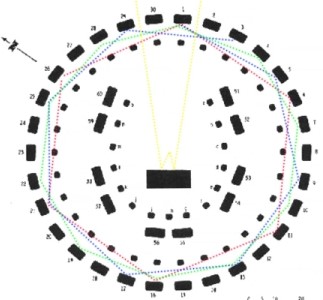
Certainly curved surfaces can focus sound and create distinctive flutter echoes, false localisation and whispering gallery effects (see the spherical Mapparium for example). But Stonehenge stones have uneven shapes and there are gaps between them, both of which will reduce the focussing. In a previous blog I wrote about how our measurements show there wasn’t strong focussed echoes in the middle of the stone circle. What happens when the talker (or whisperer!) and listener are at the edge of the circle?
I and colleagues Richard Hughes and Bruno Fazenda have been exploring what really happens when sound circulates just inside the outer sarsen circle. We’ll start by looking at some computer simulations, and then look at what the measurements in the acoustic scale model of Stonehenge show.
What is a whispering gallery?
Let’s start by looking at an authentic whispering gallery, to see what we’d expect if Stonehenge worked in that way. When someone talks along a concave wall, you can get sound that stays close to the edge. Figure 1 shows a classic way of illustrating this, considering sound to be a snooker ball bouncing around a circular table.

But modelling sound as a bouncing ball doesn’t work when you get wave effects like diffraction. So Rick simulated sound more accurately using a method called Finite Difference Time Domain (FDTD). Look out for the whispering gallery wave in the video below, it’s the one that takes the longest time to get to the bottom of the circle, hugging the wall all the way. (If you’re unclear which part of the wavefront to look at, see Figure 3).
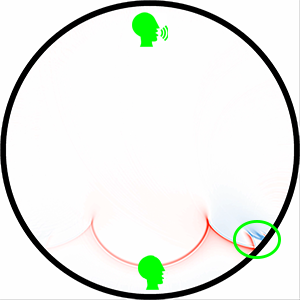
Figure 4 shows the response you’d pick up on a microphone at the bottom of the circle if the person made a short impulsive sound at the top (e.g. clapped their hands). First sound peak is the direct sound travelling straight across the circle from top to bottom. The very last peak to arrive is the whispering gallery wave, because it follows the longest path around the edge. Notice how much louder it is than the direct sound; this is a key feature of classic whispering galleries like St Paul’s Cathedral. The sound hugging the walls is surprisingly loud compared to the sound going direct across the circle, making the whispers appear to emerge from the walls.
You can also see a series of peaks arriving a bit earlier created by reflections from the side. These are easier to describe if we revert back to approximating sound as a snooker ball. The peak labelled “(1)” has reflected from the side of the circle once at 3 o’clock. Figure 5 illustrates this reflection path for high frequency sound.

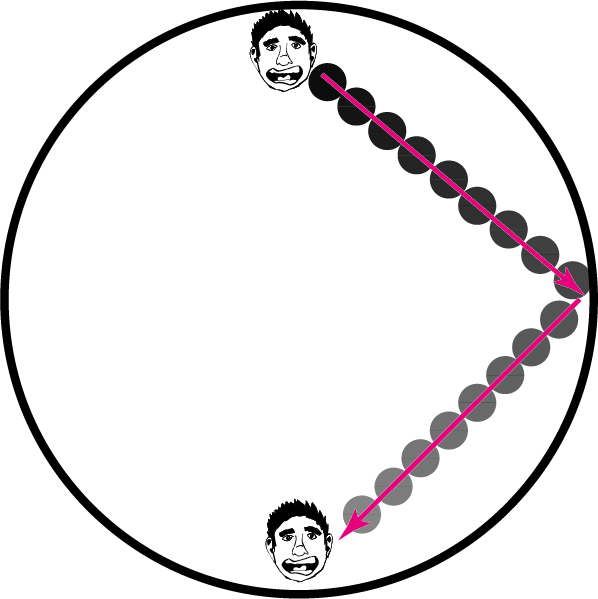
Whispering gallery with gaps?
There are gaps between the sarsen uprights in Stonehenge, what does that do to whispering gallery waves? Let’s start by looking at a simplified case of broken circle. I thought it was best shown side-by-side with the complete circle.
With the broken circle, as the sound skims past the gaps, diffraction creates little circular wavefronts going in all directions. This means the whispering gallery wave hugging the wall gradually diminishes. Figure 7 shows the impulse response. By the time the sound reaches the bottom, the whispering gallery wave is no longer visible.
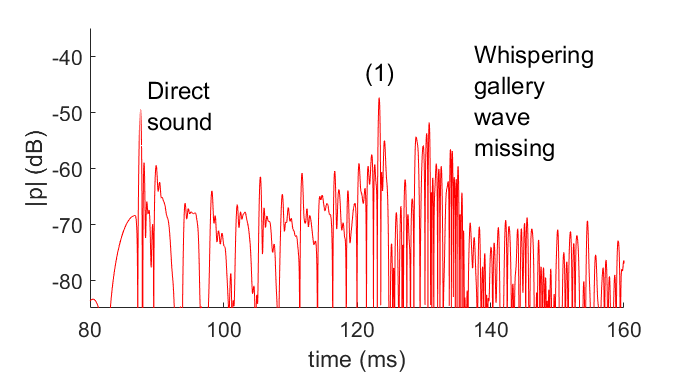
What about Stonehenge?
With Stonehenge we don’t just have gaps, we also have the irregular shapes of the stones. Also, there are other stones that get in the way, like the the bluestone circles and the inner trilithon. As the video in Figure 8 and the impulse response in Figure 9 show, there is no whispering gallery effect in Stonehenge.
We’ve also lost the focussed reflections that happened with circles – there is no stand-out reflection around the label (1). These are lost due to diffraction and scattering from the obstructing inner stones.

Measurements
The simulations have a number of limitations, not least they are in 2D using a plane cut through the Stonehenge model at about chest height. Real Stonehenge is 3D! So we used our 1:12 acoustic scale model of Stonehenge to see if we could measure any whispering gallery waves. Figure 10 shows the set-up for the shortest source to receiver distance. We measured six microphone positions roughly evenly spaced around the circle, the closest being the one you can see in Figure 10, and the furthest having the microphone on the opposite side of the circle.

Figure 11 shows the impulse responses for the 6 microphone positions. Any whispering gallery wave should show up roughly around the time where the magenta line is marked in the middle of the plots. No evidence of whispering gallery waves are seen because there are no prominent reflections.
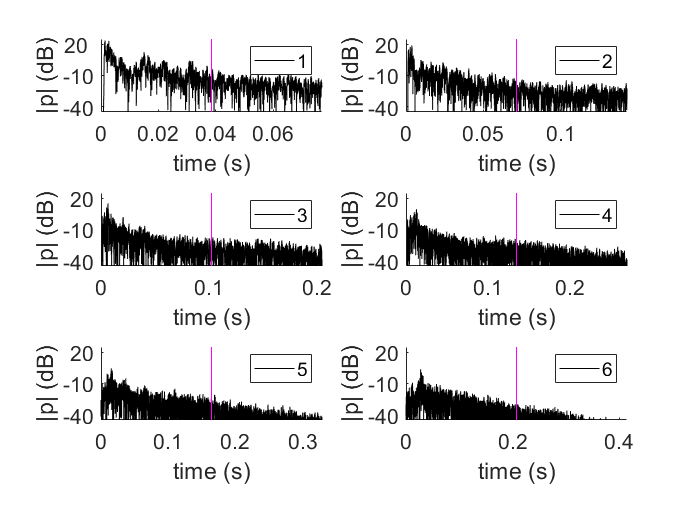
Summary
No evidence of whispering gallery waves in Stonehenge are seen in a FDTD computer simulation and also measurements in an 1:12 acoustic scale model. This happens because gaps between the outer sarsen uprights attenuate the whispering gallery waves, as does the somewhat irregular shape of the stones.
Furthermore, reflections from the outer sarsen circle don’t create “a series of discrete delays or echoes sounding somewhat like a galloping horse.” This is mostly due to the presence of many other stones that scatter the sound and attenuate any focussed reflections.
Credits
Ear icon: By ScotXW, based on work by Tatmouss – File:00-Main-hand.jpg, CC BY-SA 3.0
[1] https://soundsofstonehenge.wordpress.com/theoretical-analysis/ accessed 27/4/20
[2] Cox, T., 2014. Sonic wonderland: A scientific odyssey of sound. Random House.
Follow me
4 responses to “Stonehenge: Whispering Gallery?”
I note you did not ask for permission to reproduce my diagram above, nor do you reference my work, or the actual text I used, rather you say “I’ve heard speculation…”. Since you are writing a piece specifically discussing my hypothesis, I thought I would comment in a little detail.
What I said in my website that you reference was “It seemed possible from this, that there might have been some sort of partial whispering gallery effect. The lack of a continuous wall, the spaces between stones, may have created a series of echoes, rather than the whispering gallery effect caused by the coherent transmission of sound around a curving stone wall, such as that found at St. Paul’s Cathedral in London, or the Baptistry at Pisa. These and other circular stone sites of ritual significance were investigated for comparison, and several were found to have well known acoustic effects. A circular stone building will be likely in most cases to have some acoustic effects.” This discussion was the result of a number of days spent at a full size model of Stonehenge in the US, at which I heard whispering gallery-like effects. This work was with your colleague Dr Bruno Fazenda, who was working at the University of Huddersfield with me at the time, and whose work brought the acoustics of Stonehenge to your attention.
It’s great to see a serious approach to the subject like your research presented here, and I very much applaud it’s rigour and detail. I completely agree there is not a whispering gallery effect as you would hear in St. Paul’s Cathedral or at the Baptistry at Pisa. This is a fairly straight-forward conclusion, as St. Paul’s is a smooth circle of stone whereas Stonehenge has gaps, as I discussed in my blog, written 10 years ago. The trouble with the sort of results you present is that it is very black and white, the question you ask is whether there is a whispering gallery effect or not. What my hypothesis suggested was that there might be “some sort of partial whispering gallery effect”, and my conclusion is in my blog that this might contribute to reverberation in the space or echoes. I don’t think that your research here refutes that or denies it conclusively.
In my own measurements in Stonehenge, the resultant impulse responses clearly show reflections, and I have values of measured and modelled reverberation times at a range of frequency ranges that show there was and is reverberation and echo in the space, Indeed you can hear echoes in the space even if you simply clap your hands. The reasons for these acoustic effects are complex, as you yourself say.
I have some questions about your conclusions. In your figure 11 you show responses at certain mic positions. Since you are using a 1:12 scale model, presumably these are scaled up, and presumably the frequency response and accurate range of measurement is limited as a result? It’s also not clear that a single pair of microphones placed so close could accurate capture all acoustic effects, especially if they were restricted to specific frequency ranges, as I implied in my original blog. Presumably some of the audio effects in your model could be shifted above the audio spectrum, would an 11kHz effect be detected by your microphone, and if not might some effects be lost when you translate the results to an equivalent full size model?
In your figure 11 there are some non-linear responses/reflections, before and after 20ms in the closest mic position 1, and at the furthest position 6 there is a clear reflection with a rise of perhaps 25dB at what looks like about 25ms, just about the point at which a delay becomes noticeable as a kind of pre-delay effect. It would be interesting to investigate in more detail. The effects we detected were not clear, obvious, constant effects, but very subtle and hard to define, and perhaps all the more difficult as a result.
In addition my suggestion was more based of frequency rather than time domain effects, on resonances rather than delays, reflections contributing to the generation of modal responses, which could perhaps then act as a kind of carrier wave for small variations of a signal, something close to frequency modulation effects than early reflections. It would be interesting to see your sophisticated and scientifically detailed approach applied in modelling the 3D frequency domain in the space, and the resonances that myself and Dr Fazenda predicted and demonstrated in the space.
I very much welcome this excellent study by Professor Cox and his colleagues, which certainly illustrates the principles behind a whispering gallery very well, along with detailed results, showing the problems with simplistically suggesting that such effects might be present in, or explain an ancient monument of this kind. My research began as a collaborative research project involving musicians, designers, acousticians, modellers, and archaeologists, and it would be interesting to see a collaborative multi-partner research project fully exploring the complex and subtle acoustic effects present at Stonehenge. My own more recent and developed research on the subject can be found here: https://www.mdpi.com/2624-599X/1/3/39
Professor Rupert Till, University of Huddersfield
Whereas I just look at Stonehenge and think “Whispering gallery? With all that irregularity and those gaps? Nah”
Agreed that was my thinking as well, but as the idea had been suggested we wanted to provide the evidence of nothing there.